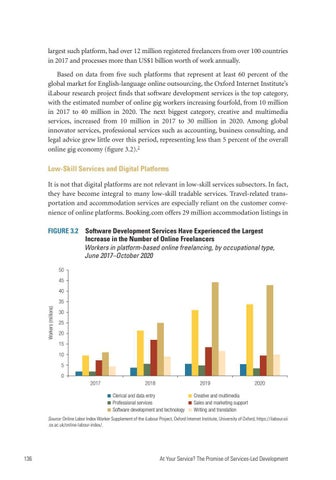largest such platform, had over 12 million registered freelancers from over 100 countries in 2017 and processes more than US$1 billion worth of work annually. Based on data from five such platforms that represent at least 60 percent of the global market for English-language online outsourcing, the Oxford Internet Institute’s iLabour research project finds that software development services is the top category, with the estimated number of online gig workers increasing fourfold, from 10 million in 2017 to 40 million in 2020. The next biggest category, creative and multimedia services, increased from 10 million in 2017 to 30 million in 2020. Among global innovator services, professional services such as accounting, business consulting, and legal advice grew little over this period, representing less than 5 percent of the overall online gig economy (figure 3.2).2
Low-Skill Services and Digital Platforms It is not that digital platforms are not relevant in low-skill services subsectors. In fact, they have become integral to many low-skill tradable services. Travel-related transportation and accommodation services are especially reliant on the customer convenience of online platforms. Booking.com offers 29 million accommodation listings in FIGURE 3.2 Software Development Services Have Experienced the Largest Increase in the Number of Online Freelancers Workers in platform-based online freelancing, by occupational type, June 2017–October 2020 50 45 40 Workers (millions)
35 30 25 20 15 10 5 0 2017
2018
2019
Clerical and data entry Professional services Software development and technology
2020
Creative and multimedia Sales and marketing support Writing and translation
Source: Online Labor Index Worker Supplement of the iLabour Project, Oxford Internet Institute, University of Oxford, https://ilabour.oii .ox.ac.uk/online-labour-index/.
136
At Your Service? The Promise of Services-Led Development

